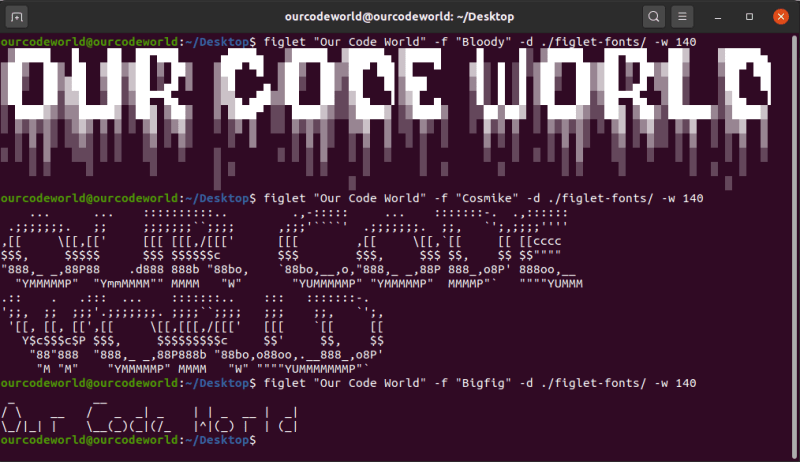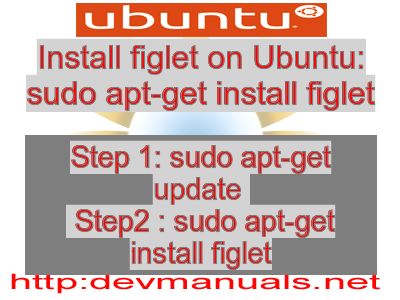
- INSTALL FIGLET FOR MAC FOR MAC
- INSTALL FIGLET FOR MAC INSTALL
- INSTALL FIGLET FOR MAC UPGRADE
- INSTALL FIGLET FOR MAC CODE
Note: If you already have a service running on port 8080, then change the port binding to 8888:8080 for instance. $ kubectl port-forward svc/gateway -n openfaas 8080:8080 Now that you've setup a cluster and OpenFaaS it's time to access the UI and API.įirst forward the port of the gateway to your local machine using kubectl. The KinD cluster will now download all the core services that make up OpenFaaS and this could take a few minutes if you're on WiFi, so run the command above and look out for "AVAILABLE" turning to 1 for everything listed. The helm CLI should print a message such as: To verify that openfaas has started, run: $ kubectl -namespace=openfaas get deployments -l "release=openfaas, app=openfaas" You can fine-tune the settings like the timeouts, how many replicas of each service run, what version you are using and more using the Helm chart readme. Note: if you see Error: could not find a ready tiller pod then wait a few moments then try again. The command above adds the OpenFaaS helm repository, then updates the local helm library and then installs OpenFaaS locally without authentication.

INSTALL FIGLET FOR MAC UPGRADE
Helm upgrade openfaas -install openfaas/openfaas \ Create the openfaas and openfaas-fn namespaces:.If you decide otherwise then checkout the documentation. Since your cluster is running locally you may want it turned off.

INSTALL FIGLET FOR MAC INSTALL
You can install OpenFaaS with authentication on or off, it's up to you.

Install the OpenFaaS CLI $ curl -sLSf | sudo sh Note: it may take a minute or two to download tiller into your cluster. Helm init -skip-refresh -upgrade -service-account tiller & kubectl create clusterrolebinding tiller \ $ kubectl -n kube-system create sa tiller \ The easiest way to install OpenFaaS is to use the helm client and its server-side equivalent tiller. Install OpenFaaS with helm Install helm and tiller $ export KUBECONFIG="$(kind get kubeconfig-path -name="openfaas")" Always, always switch context into your new cluster before making changes. Now there is something you must not forget if you work with other remote clusters. ⠈⡱ Starting Kubernetes (this may take a minute) ☸ ✓ Ensuring node image (kindest/node:v1.12.2) 🖼 Why try to remove and delete all the objects you created between tests when you can just spin up an entirely fresh cluster in about the same time? $ kind create cluster -name openfaas I find this useful because OpenFaaS ships plain YAML files and a helm chart and I need to test both independently on a clean and fresh cluster. Create one or more clustersĪnother neat feature of kind is the ability to create one or more named clusters. Or if you don't want to install Golang on your system you can grab a binary from the release page. You can get the latest and greatest by running the following command (if you have Go installed locally) $ go get /kind I like to install it via the binary release here. The kubectl command is the main CLI needed to operate Kubernetes. On a Linux host or Linux VM type in $ curl -sLS | sudo sh.ĭownload Docker Desktop for Windows or Mac. This is also a nice experience for developers because it's the same on MacOS, Linux and Windows.
INSTALL FIGLET FOR MAC FOR MAC
Unlike prior development environments for Kubernetes such as Docker for Mac or minikube - the only requirement for your system is Docker which means you can install this almost anywhere you can get docker installed. A large number of them have also written blog posts and held events all over the world.įind out more about OpenFaaS on the blog or GitHub openfaas/faas Pre-reqs Over the past two years more than 160 developers have contributed to code, documentation and packaging.

INSTALL FIGLET FOR MAC CODE
The widely accepted OCI/Docker image format is used to package and deploy your code and can be run on any cloud. With OpenFaaS can run stateless microservices and functions with a single control-plane that focuses on ease of use on top of Kubernetes. It is open-source and built by developers, for developers in the open with a growing and welcoming community. The mission of OpenFaaS is to Make Serverless Functions Simple. You can read my introductory blog post Be KinD to Yourself here. In this post I want to show you how I've started deploying OpenFaaS with the new tool from the Kubernetes community named Kubernetes in Docker or KinD.


 0 kommentar(er)
0 kommentar(er)
